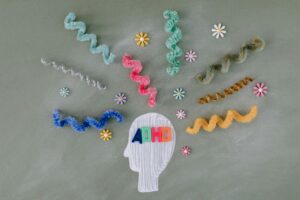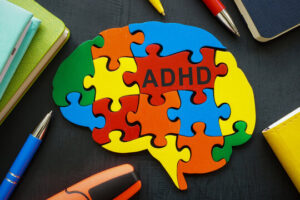Life with ADHD: Signs, Symptoms, Treatment Options, and How Medication Improves Focus
Living with ADHD (Attention-Deficit/
In this blog, we’ll explore what life with ADHD really looks like, including the signs and symptoms, daily struggles, treatment and management options, and how medication works with brain chemistry to improve focus and attention.
What is ADHD?
ADHD is a neurodevelopmental disorder that affects both children and adults. It impacts executive functioning—the brain’s ability to manage tasks, regulate emotions, and sustain attention. According to the CDC, approximately 10% of children and about 4-5% of adults in the U.S. live with ADHD.
The condition is often misunderstood as simply being “hyper” or “easily distracted,” but ADHD is more complex and can significantly interfere with academic, social, and occupational success.
Signs and Symptoms of ADHD
1. Inattentive Symptoms
People with the inattentive type of ADHD often struggle with:
- Difficulty focusing on tasks or conversations
- Frequently losing items (e.g., keys, phone, schoolwork)
- Making careless mistakes in work or studies
- Forgetfulness in daily activities
- Struggling to follow through on instructions
- Avoiding tasks that require sustained attention
2. Hyperactive-Impulsive Symptoms
The hyperactive-impulsive type of ADHD includes:
- Fidgeting or tapping hands or feet
- Inability to stay seated in calm settings
- Talking excessively or blurting out answers
- Interrupting others frequently
- Acting without thinking
- Difficulty waiting in lines or turns
3. Combined Type
Many people show signs of both inattentiveness and hyperactivity/impulsivity—this is known as the combined type of ADHD.
How ADHD Affects Daily Life
Living with ADHD can feel like having a powerful engine with faulty brakes. The mind races, attention shifts constantly, and focus becomes an uphill battle. People with ADHD may experience:
- Chronic disorganization
- Missed deadlines or forgetfulness
- Trouble managing time and prioritizing
- Relationship challenges due to impulsivity or emotional dysregulation
- Low self-esteem from repeated failures or criticism
- Emotional outbursts or mood swings
Without treatment, ADHD can contribute to poor academic or job performance, anxiety, depression, and strained relationships.

ADHD Management: Treatment Options That Work
ADHD is manageable with a comprehensive, multi-faceted approach that combines medical, psychological, and lifestyle interventions.
1. Behavioral Therapy
Cognitive Behavioral Therapy (CBT) helps individuals:
- Reframe negative thought patterns
- Improve problem-solving and planning
- Develop routines and structure
- Manage emotional regulation
Parent training is also helpful for children with ADHD to improve parenting techniques and behavior management strategies.
2. ADHD Coaching and Skill-Building
- Coaches help individuals create systems for time management, organization, and setting goals.
- Skill-building workshops offer tools for better task initiation, focus, and habit formation.
3. Lifestyle Modifications
- Exercise boosts dopamine and helps regulate mood and energy.
- Mindfulness and meditation improve self-awareness and reduce impulsivity.
- Diet and sleep hygiene play critical roles in stabilizing mood and cognitive function.
4. Educational and Workplace Support
- 504 plans or IEPs in schools
- Workplace accommodations such as flexible deadlines or quiet workspaces
- Tools like noise-canceling headphones, timers, or visual planners
How ADHD Medication Works: A Look Inside the Brain
One of the most effective components of ADHD treatment is medication. When used responsibly and under professional supervision, ADHD medications can significantly improve focus, attention, and self-control.
The Role of Neurotransmitters in ADHD
ADHD is associated with low levels of dopamine and norepinephrine—chemicals in the brain that regulate attention, motivation, and impulse control.
ADHD medications work by increasing the levels of these neurotransmitters, thereby improving communication between different areas of the brain responsible for focus and executive function.
Types of ADHD Medication
1. Stimulants (Most Commonly Prescribed)
These are the first-line treatment for most individuals with ADHD.
Examples:
- Methylphenidate (Ritalin, Concerta)
- Amphetamine-based medications (Adderall, Vyvanse)
How They Work:
- Increase dopamine and norepinephrine levels in the brain
- Help improve focus, reduce impulsivity, and enhance task completion
Effectiveness:
- 70-80% of individuals with ADHD see significant symptom improvement
2. Non-Stimulants
Used when stimulants are not effective or cause side effects.
Examples:
- Atomoxetine (Strattera)
- Guanfacine (Intuniv)
- Clonidine (Kapvay)
How They Work:
- Target norepinephrine systems
- Improve attention and emotional regulation over time
Benefits of ADHD Medication
- Improved concentration and task completion
- Reduced impulsive and hyperactive behavior
- Better emotional control and mood stability
- Increased academic and workplace performance
- Enhanced confidence and self-esteem
Conclusion: Life with ADHD Can Be Empowering
ADHD is not a flaw—it’s a different way of processing the world. With the right diagnosis, support, and treatment, individuals with ADHD can channel their energy, creativity, and drive into fulfilling lives.
Understanding the symptoms of ADHD, exploring treatment options, and learning how medication interacts with the brain can help reduce stigma and empower those living with ADHD to seek help and build a future on their own terms.
If you or a loved one suspects ADHD, consult a licensed mental health or medical professional. There is no one-size-fits-all solution, but there is always a way forward.
Keywords: Life with ADHD ; ADHD symptoms in adults and children; ADHD medication and brain chemistry; How to treat ADHD; ADHD management options; ADHD focus improvement; ADHD therapy and medication
